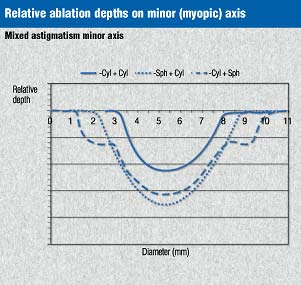‘Double-card’ LASIK ablation plan works well for mixed astigmatism
Treating minus cylinder followed by plus sphere is the best approach given current regulatory restrictions.
NEW YORK — LASIK can be used successfully for treatment of complex astigmatism, even though not all LASIK techniques for astigmatism treatment are available to surgeons in the United States, according to Y. Ralph Chu, MD. Dr. Chu prefers LASIK for astigmatism even after cataract surgery or clear lens extraction, he said here at the Ninth Annual Ocular Surgery News Symposium.
“I do it 3 months after a cataract or a clear lens extraction or for any residual astigmatism,” said Dr. Chu. “I’ve had good experience with some of the toric IOLs that I’ve used, but I don’t perform astigmatic keratotomies or limbal relaxing incisions any more.”
Dr. Chu uses Allergan’s Amadeus microkeratome and a “double-card” technique to treat mixed astigmatism. “One of the most challenging things that we all encounter is patients with mixed astigmatism,” said Dr. Chu. “You can treat the minus sphere and the plus cylinder. You can treat the plus sphere and the minus cylinder, or you can do the crossed cylinder technique. With no current hyperopic astigmatism approval in the United States, I’ve been using a two-card technique, treating the minus cylinder followed by the plus sphere. The crossed cylinder technique minimizes tissue ablation and has a faster time than the technique I use, so I analyzed my data to see if I was still providing patients with a safe treatment,” he said.
(Editor’s note: The excimer laser Dr. Chu uses, the Visx Star, is approved for hyperopia treatment and for astigmatism treatment in the United States. By using two programming cards he can treat both components of refractive error in the same sitting.)
Patient outcomes
 Dr. Chu reported on 76 eyes in 45 patients,
with a mean age of 45. “The preop sphere was about +0.5 D, but the range
is pretty large from –3.75 D to +4.50 D, with the preop astigmatism
ranging from –1.25 D to +5.75 D,” he said.
Dr. Chu reported on 76 eyes in 45 patients,
with a mean age of 45. “The preop sphere was about +0.5 D, but the range
is pretty large from –3.75 D to +4.50 D, with the preop astigmatism
ranging from –1.25 D to +5.75 D,” he said.
He reported on 1-month follow-up on 47 eyes, or 62% of all patients:
“In terms of deviation from emmetropia, we have about 45% to 48% between ±0.5 D, and 77% to 72% between ±1 D,” he reported. One day postop, 56% of patients were 20/40 or better; 1 month postop, 72% were 20/40 or better. About 30% were 20/25 or better at 1 day and 1 month postop. “I think these numbers are low basically because some of these patients had very, very high degrees of mixed astigmatism,” said Dr. Chu.
His recommendations for treatment of mixed astigmatism include the following:
“Basically, I recommend that surgeons do the lower degrees, anything under 3 D of astigmatism without too much hyperopia. When you convert from the plus cylinder to the minus cylinder form you should have an excellent result. I also look very carefully at these patients for corneal thickness, because the double-card technique takes a little more tissue off than the crossed cylinder technique. But I find that the results for vision are acceptable; patients are really happy. So if you stay within the low degrees of mixed astigmatism and watch the pachymetry carefully, I think you’ll be happy with the double-card technique at least until we can evaluate some of the crossed cylinder studies on hyperopic astigmatism when it becomes available.”
New microkeratome
 After using Allergan’s Amadeus
microkeratome on 100 eyes, what struck Dr. Chu most was the tool’s ease of
use. “There are three main points that I find really attractive with the
Amadeus,” he said. “There is no on-eye assembly, once you get suction
you basically have a keratectomy. Its simplified design and operation minimizes
errors and shortens the learning curve. And all the action takes place within
the protected space of the suction ring to avoid interference and ensure a
consistently smooth, quality pass.”
After using Allergan’s Amadeus
microkeratome on 100 eyes, what struck Dr. Chu most was the tool’s ease of
use. “There are three main points that I find really attractive with the
Amadeus,” he said. “There is no on-eye assembly, once you get suction
you basically have a keratectomy. Its simplified design and operation minimizes
errors and shortens the learning curve. And all the action takes place within
the protected space of the suction ring to avoid interference and ensure a
consistently smooth, quality pass.”
The microkeratome is a titanium unit composed of three pieces — the suction head, blade holder and handpiece. It has 160 µm and 180 µm heads and multiple built-in sensors for safety, according to Dr. Chu.
“It has single port suction, but there is an interior suction channel for 360° suction. The suction comes off the back port, so depending on your preference you can adjust the hinge size to prevent free caps,” he said.
The microkeratome can be driven automatically from a computer touch screen.
“There are only two pedals that control it. Basically you step on the pedal once to get suction, and step on it another time to allow the blade to translate and complete the keratectomy, and the suction comes off on its own” explained Dr. Chu.
For Your Information:
- Y. Ralph Chu, MD, can be reached at 7760 France Ave. So., Edina, MN 55435; (612) 835-1235; fax: (952) 835-1092; e-mail: yrchu@chulasereye.com. Dr. Chu is a paid consultant for Allergan.
- For information on the Allergan Amadeus microkeratome, contact the company at 2525 Dupont Dr., Irvine CA 92612; fax: (714) 246-6987.
